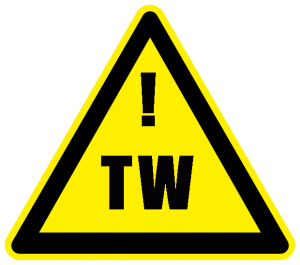it’s too bad everyday life doesn’t come with a trigger warning

As a survivor of many sorts, I appreciate the newly popular use of “trigger warnings” – warnings appearing before an article/forum/email to let the reader/listener know the context may cause strong emotions or fear. These are often used surrounding discussions of rape, violence against women, fat-phobia, and many forms of violence systematically engrained into personal interactions. Trigger warnings encourage a type of check-in on yourself that considers the following:
- Will exposing myself to this article/forum/email make me feel (the bad kind of) vulnerable or unsafe?
- What privileges do I have in order to detach my own experiences from the violence described in this piece?
- Will reading or watching this empower and validate my experiences based on how I am feeling right now?
Trigger warnings used in articles or forums have the potential for survivors to open up in ways that are empowering and protect people anywhere on the spectrum in healing. They create space to tell and digest their own stories. Too often these stories are censored or untold due to pressure from outsiders who deem them too taboo or “hurtful” to talk through. In a sense, trigger warnings protest comments like: Why are you still upset? Bringing this will hurt you. Why are you making me uncomfortable? They make space for voices and stories that go beyond the “comfortable” because they are worthy of taking up space.
But these labels of “violence against women” or “sexualised violence” do not provide full protection or warning. They only categorise experiences, while these experiences carry moments that include triggers that I cannot quite articulate because violence occurred in the every day and in every day moments. Just because a piece or a video does not come with a warning label, does not mean that they do not have the potential to trigger memories or emotions of the past.
I carry a lot of shame in the things that trigger me – trigger my memories of hurt, prick at feelings I manage to hide in the every day. This is not to say that I have shame in having these emotions or experiences, but I have shame from not being able to articulate, validate, or share why seeing a towel on the floor or bells dangling from a door handle brings back recollections of violence in full force. I cringe every time I hear the words “sprout” and “babe” or smell peanut m&ms. It feel irrational as these wounds are attached to daily moments that do not come with labels of “domestic violence” the way articles do. In my mind, in my experiences, seeing a towel on the floor brings back just as many memories as the phrase “domestic violence” in an Adios, Barbie post.
As long as we live, touch, and share amongst everything, anything can become a trigger. The sooner that violence is talked about and considered real, the sooner we can discuss how they fit into real and every day moments. In recognising that anything from red nails to a commercial jingle can uproot deeply engrained memories, survivors (of any kind) will have the potential to speak and take up space. We are more than words and labels.

